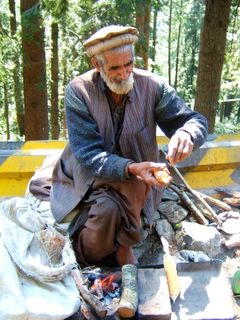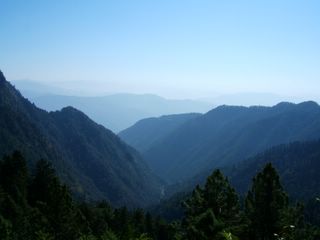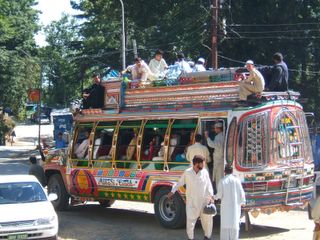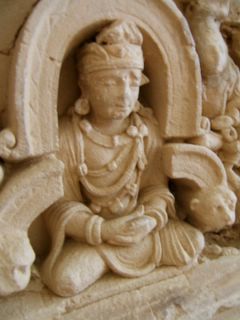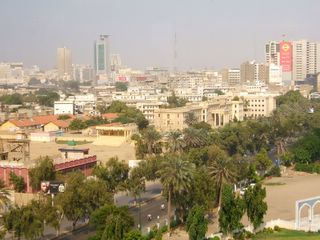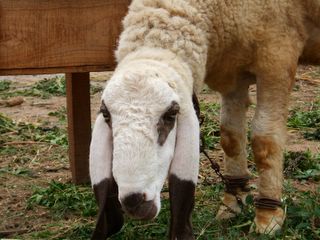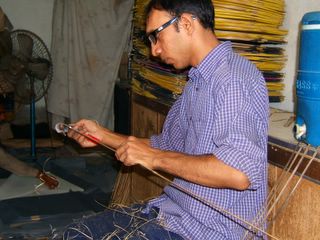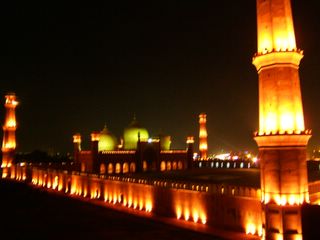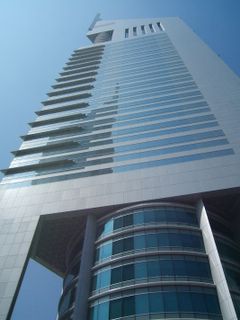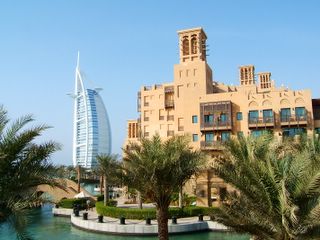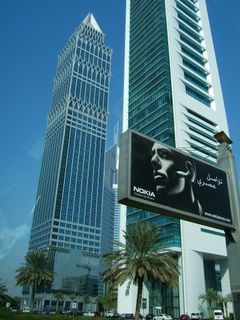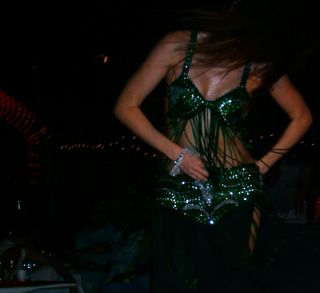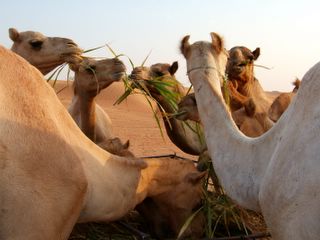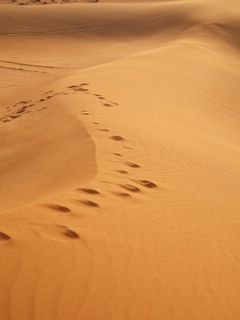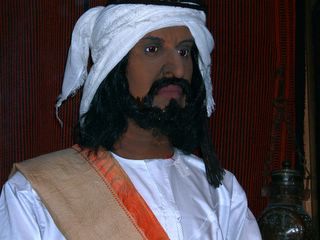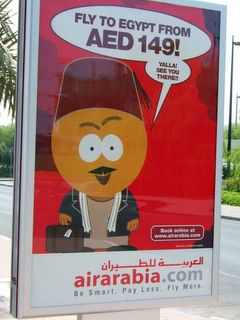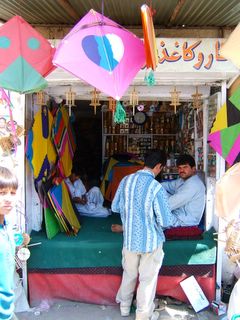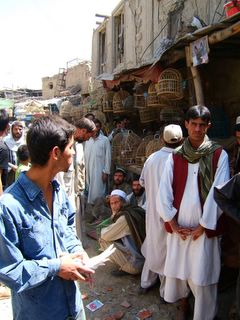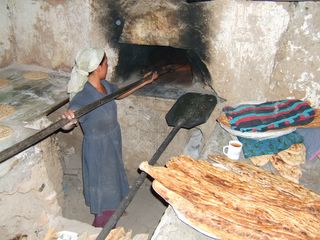Tuesday, September 27, 2005
In the Foothills of the Himalayas
I woke up before dawn (very unlike me) to drive into the foothills of the Himalayas. I don’t think it’s quite fair that anything above 8,000 feet be considered a foothill. In my book, it’s a mountain, no matter how high the peaks surrounding it.
We drove a narrow, winding road littered with fallen rock, distressed motorists, and the occasional road slide down the mountain. It was terrifying. I was certain a jingle truck would butt us off a cliff, though the greater danger was the smaller cars, intent on passing these slow-moving trucks. But we made it the trail head at Ayubia (8,300 ft), had milky chai from a wooden stall just outside the gates. I shivered in the cold, and cursed myself for not bringing along my heavy Afghan shawl. By the time we finished our tea, however, the weather had warmed and the walk was quite pleasant. I’d sound a lot more exciting if I called it a hike, but the path, along the route of a pipeline laid by the British, was completely flat. For those from San Mateo, consider it the Sawyer Camp Trail of Pakistan. We could see Kashmir in the distance and hear the occasional cry of a monkey in the trees above. Village women along the trail gathered firewood and fodder for their animals, wrapping their scarves around their faces at the sight of the men in our company.
Once through the park, we stopped to take photos and C, an American who grew up in Pakistan, bought an ear of grilled corn from an elderly vendor. C didn’t get to eat much of it. We hadn’t gone more than 100 yards when a troop of monkeys spotted us and attacked. C, no innocent when it comes to monkeys, lost no time in hurling the corn cob at them and the monkeys disbursed, triumphant. I hate monkeys.
We bought honey from an old man on a mountaintop then drove to Murree. C had attended an international Christian school there and wanted to revisit his old stomping grounds. If the name sounds vaguely familiar, it’s because in 2002, not long after C left, it was attacked by terrorists. Six Pakistani staff members were shot and killed. By some miracle, none of the children were injured.
The school was architecturally clever, a converted church complete with computer labs and lounges. But it was one of the saddest places I’ve been in a long time. Since the attack, the place had been turned into a veritable fortress of gun turrets and barbed wire. The security was impressive, intelligent, and utterly depressing. A friend of C’s at the school gave us a tour, pointing out where this and that acquaintance of C’s had been killed or shot. Most of the bullet holes had been plastered over, but a few remained.
Monday, September 26, 2005
Sunday, September 25, 2005
Taxila
A colleague and I drove out to Taxila, site of an ancient Buddhist/Greek/Parthian/Scythian/etc., etc. civilization, dating from the 6th century BC. I went on line to learn more about it, but the UNESCO World Heritage site was the best I could do, and it was annoyingly coy.
Though it is a world heritage site and quite extensive, it isn't much to look at. The best pieces have been carted off to the Taxila museum, leaving only broken stone walls and a few stupas with carvings no more than eight inches high. But, the Buddhas and other carvings in the museum were stunning, and I particularly enjoyed the display of ancient childrens' toys -- terracotta animals pulling terracotta chariots with wheels that actually turned.
We visited three of ruined Buddhist monasteries: Dharmarajika, Mohra Moradu, and Jaulian. At each we were greeted by official guides demanding baksheesh, which we ended up paying as we had little choice. The curator at the museum was most adept in his demands, barricading us inside the gold room until we paid up. When my colleague's tribute wasn't enough and he showed his empty pockets, the man whined that he'd like an "American" pen. I offered my Pakistani ballpoint, but he turned his nose up at it, and we left.
At Dharmarajika, the first person we encountered was a palsied old man selling replicas of the stone carvings. His hands shook so bad I felt I had to take the tiny carvings before he dropped them, and I ended up buying two stone Buddhas I don't need just because I felt bad for him. I confirmed that these were replicas, as I don't want to be arrested at the airport for smuggling antiquities, and he assured me they were... but he had some real ones if I'd prefer them instead. Er, no. Men selling these knicknacks were at the other two sites as well, so I feel reassured that I will not be tossed to the ground and cuffed by zealous customs inspectors as I pass through the Islamabad Airport this week.
Wednesday, September 21, 2005
Islamablah
I returned from Karachi to my latest home away from hygiene, Islamabad. There’s a severe shortage of hotel rooms here, so if you come to Islamabad (and I don’t see why you would) reserve in advance. For myself, I’ve been bounced from one hotel to another, and have most recently been demoted from the luxuries of 5-star digs to a comfortable if moldy guesthouse across the street from my favorite strip mall. That Islamabad has strip malls should tell you most of what you need to know about the place. That I haven’t posted any pictures of it (yet – I must get some snaps of the wacky, 70s-style government buildings, assuming I won’t be beaten for it by the security forces) should tell you the rest.
It’s not a bad place. The city is surprisingly green, with fecund-smelling parks running alongside the wide streets. The sewers run underground. I can walk about without a headscarf, if I don’t mind being shadowed threateningly by eager cabbies. They trail slowly behind me in their yellow and black jalopies, tooting their horns and craning their heads at me out their windows as they crawl past. It’s really annoying when I try to cross a street, and can’t move forward because the cabs are determined that I should get inside rather than get across.
The cabbies go through this ritual every time they drive past a pedestrian. I want to yell at them that if I wanted a cab, I wouldn’t be walking down the sidewalk; I’d be standing at the edge of the street facing the traffic and waving, and STOP FOLLOWING ME!
But that remains a fantasy. I don’t speak Urdu, and while most people speak English here, they don’t speak it well enough to be told off in it. Besides, there are far too many cabs.
Tuesday, September 20, 2005
Karachi
I'm probably being unfair to Karachi, because I honestly didn't see very much of it. But I didn't want to. I'd been warned not to go anywhere on my own, and since I was traveling on my own, well... Besides which, I've been traveling so long now that the thrill of a new touristic experience has worn off. I'm just tired.
Take Lahore, subtract the charm, add the seediness of a port city, and you've got Karachi. Blech.
But the sewers run underground!
Thursday, September 15, 2005
Back in Lahore (Pakistan)
Lahore looks much different when I’m working. On my vacation in May, it was bathed in a happy, I’m-Not-In-Kabul glow, accentuated by the company of a great travel companion. But now, the din of its traffic seems unbearable, the humidity miserable, the abject poverty intolerable.
I stay in the Pearl Continental, a luxe 5-star. The staff are still wearing those ridiculous “I Care!” buttons and still caring far too much. I find myself tripping over them. And while my head rests upon a goose-down pillow, I hear the wail of a child outside – a child that lives on these festering streets.
By day I tramp down refuse-strewn back alleys, talking to men who make kites for a living, mix dyes, fix cars. I stumble into rural villages in the middle of the big city – the city simply grew around them, leaving their brick roads and low marshes intact. There I meet with women who make shampoo for P&G out of their homes (and I thought Head and Shoulders came from a factory), and help run the family shop.
And then I dine at the best restaurant in Pakistan, the Cooko’s Den. Cooko’s is a rooftop restaurant, sandwiched between Lahore’s great fort and its infamous red light district. The owner, Iqbal Hussain, is a famous artist and a child of the brothels. He paints the dancing (Nauch) girls, and the paintings are unromantic and very human. The waiters lower the meat orders to the street, where the vendors below grill up kebobs, then load them into a metal tray which is pulled five floors up to the roof. I think/hope my vegetarian meal was prepared in the kitchen, one floor down. The views of the fort at night are spectacular, and the cool breeze a welcome relief.
I’m starting to wonder that I can transit between such wealth and such poverty so easily. I don’t feel guilty about staying in nice hotels and eating well. I feel grateful and damn lucky. But the squalor of poverty in Lahore beggars belief, and even while I enjoy my nightly breaks from it in glamorous hotels the contrast whipsaws me.
I don’t know how people can keep going under these conditions, but they do.
Wednesday, September 14, 2005
Economics, Politics
Dubai has reinvented itself, and today only 20% of economic production comes from oil. Trading, manufacturing and services, particularly tourism, account for the rest. Dubai’s dry dock is the largest in the world, and loading cranes dot the Dubai “creek”, a stumpy waterway. In spite of the economic inroads, however, women are still second-class citizens. This is a big step up from Afghanistan.
Anyway, to put it plainly, this is the land of themed shopping malls. I dedicated my last day in Dubai to retail therapy.
First stop, the mall beneath the Emirates Towers. I had attempted to dress nicely today, knowing I was in a world of serious shoppers with serious money. But there was no way I could live up to the standards beneath the Emirates Towers. I ignored the designer boutiques (I’d only embarrass myself) and took shelter in a Starbucks, where, flustered amidst the bold and the beautiful, I bought the most expensive frapuccino of my life and promptly became ill.
I staggered off to the gold souk to redeem myself. Apparently, Dubai has the best gold prices in the world, and the gold souk is no tourist trap. It’s where people go to haggle over $20,000 sets of wedding jewelry. I love these dowry pieces of intricate gold, but didn’t have $20k to spare, so settled for smaller, more modest, earrings and a necklace in reddish 22k. And yes, the price was surprisingly good, even though my bargaining went something like this:
Me: Er, I’ve been told I need to bargain with you.
Gold seller: No, you don’t.
Me: No, I think I do.
Gold seller: No, really, you don’t.
Me (weakly): Is that your best price?
Gold seller: This is my best price.
Me: Okaaaay then.
Gold seller, five minutes later, as he’s writing my receipt and after I have given no further argument, and he realizes I truly am as pathetic at bargaining as I appear (sighing): I’ll take $20 off.
I wore the gold out of the souk, and emboldened by my new look, charged off to the Ibn Battuta mall. Ibn Battuta was a famous Arab explorer, and the mall is themed after his travels. It’s HUGE. Imagine Epcot center. Now imagine it entirely enclosed and air conditioned, and one big shopping mall, and you have some idea of the scale of this place. I entered in China, bought a silk wrap in Persia, and had a Starbucks tea in India.
Another taxi ride took me to the souk Maderat Jameira. This is a modern mall designed to look like an old souk, with high, wood-beamed ceilings and incense wafting on the air. It sits on the water between splendid hotels and has a view of the Crowne Plaza’s famous sail-shaped hotel. In order to give you a better picture of just how much money flows through this place, in one of the shops they were selling a necklace containing a single 794-karat amethyst. The scary thing is they tried to sell it to me. I credit the new gold bling I wore.
In a further bid to build tourism, Dubai is in the process of building an amusement park: Dubai Land. If the malls, museums, and sheer glitz is anything to go by, Dubai will give Disneyland a run for its money.
http://adventurersclub.blogspot.com
Monday, September 12, 2005
Day 2: Dunes
Friday is the first day of the weekend in the UAE, and as little was open I stayed I lounged and ate. A lot. The, in the afternoon I went on my long-anticipated dune tour. Our driver knew what he was doing, but he delighted in taking the most sickening routes across the dunes. We fishtailed, lurched, slid sideways down the steep dunes, and sent up sprays of sand as if whipping through puddles of water. My lunch, earlier a source of satisfaction, was now was threatening a return visit.
I was never so happy to see camels, for we had a scheduled stop at a camel farm. The place smelled just like that carpet I bought in Afghanistan. (I finally removed the odor after two washings and a thorough spraying with Lysol).
Regretfully, I said goodbye to the camels and returned to the 4x4 for more torture, keeping my eye on my watch and praying for sunset. As the sun began to sink, we stopped atop a tall dune for the sand boarding. By this time, I felt so nauseated I wasn’t sure I’d be able to stand up, much less surf the dune. Fortunately, we only had two boards and three hopeful sand-boarders, so I let the others go first and got a chance to center myself.
But my rest ended all too quickly, and I was strapped onto a board atop a frighteningly high dune. Much to my surprise, I glided easily down it. I’ve never snowboarded, but have been told that sand-boarding is slower and easier. Makes sense – sand must have more traction than snow. However, I seem to remember snow being much easier to walk up. After trudging up the hill twice I felt ready to collapse, face-down in the warm red sand. Between the heat and my sedentary Kabul lifestyle, I was done-in.
Dusk lasted about 15 minutes and then the night became black as pitch. Funny how quickly darkness falls in the desert. We drove to a permanent encampment where dinner and bellydancing awaited. Again, I was too nauseous to do more than nibble at some flat bread and weakly applaud the dancer.
Sunday, September 11, 2005
Dubai: Day 1
Once ensconced in my hotel, I hit the city. My first tourist stop in Dubai (because it happened to be across the street from a great Mexican restaurant, Barry’s Beach) was the Dubai museum, located inside an old fort. To my astonishment, beneath the usual exhibits of old canons and mud huts, topiside, lay a Disney-esque recreation (it even ended in a souvenir shop) of old Dubai, archaeological digs, and the sea floor.
It should have been wildly educational, and I was keenly interested in the economic history of this place, but all I could think was that the mannekins looked a lot like the marionette terrorists in Team America, and the female mannekins in their black burqas (or whatever they’re called here), inevitably facing away from the live passerby, were even freakier than real women in burqas, which dehumanize the wearer. It would be a great spot to film a James Bond movie. Imagine: a baddie could disguise himself as one of the female mannekins then spin around and attack an unsuspecting Bond with his curved blade. Eeek!
I then went to the Mercado shopping mall, which was far too upscale for the likes of me. I felt very poor and grimy, and crept back to my hotel.
Wednesday, September 07, 2005
Tuesday, September 06, 2005
The Countdown
Things are starting to hot up in the provinces as the September 18th parliamentary elections draw closer. A British security contractor was kidnapped and killed, election candidates and pro-government mullahs are being assassinated at an alarming rate, and the warnings from various security agencies are coming thicker and faster. In Kabul it’s business as usual, but all in all, I’m glad to be leaving this Thursday.
I know aid workers here who’ve pretty much barricaded themselves in their rooms during their last week in-country. Steve was killed a mere week before he was to go home, and that’s fed the fires of superstition. But I’m so busy trying to finish everything before I leave and preparing for my next assignment in Pakistan, that I haven’t had time for the well-meant warnings to stay in during my final days here.
Three more days, and I’m off to Dubai.
Monday, September 05, 2005
Sunday, September 04, 2005
The Bird Market
The Bird Market of Kabul squats in the old city. That part of Kabul is 1,000 years old, though the buildings are not. It's a winding, muddy bazaar, filled with hawkers' cries and the pong of rotting garbage, and the Bird Market makes up one long, narrow alleyway cutting through the middle.
An acquaintance of mine had put together a "tour" of the Bird Market, the kite shops, and Singer's Alley. Had it not been for him, I would not have gotten to the Bird Market under my own steam, because it is the least female-friendly part of Kabul I've ever experienced. Men and boys clustered around me, staring as if they'd never seen a woman before. Those with cellphones whipped them out to take pictures. Since I've taken enough pictures of innocent and unwary Afghans, I couldn't really complain about that, but the crush of gathering men was uncomfortable, and I was glad to leave the place.
The kite shops and Singer's Alley (really a string of stores near the kite shops) were on open roads on the outskirts of the bazaar, and a more comfortable place to walk. Singers hire themselves out by the day from Singer's Alley, and men and boys cluster around the kite shops, examining the wares with a critical eye. Although kite flying is not as popular as it apprently once was, it's unusual to look up in the sky and not see a brightly-colored paper kite bobbing in the mountain wind.
Saturday, September 03, 2005
When You Wish Upon a Star...
...and then discover it's actually an anti-missile flare from a helicopter, you feel a bit foolish, as well as disappointed. It was a great wish!
Note to self: flares are reddish, shooting stars are not.
http://adventurersclub.blogspot.com
Friday, September 02, 2005
Qasaba...
…is a suburban slum on the outskirts of Kabul, behind the airport. Dust devils spiral lazily through the garbage-strewn tracts of dirt, which are broken only by stunted grey bits of scrub. Kuchi nomads drive their goatherds through these parched strips between derelict Russian apartment blocks.
Goats really will eat anything.
I was there to do some market research for a poster advertising campaign. Since most microfinance clients are illiterate, I’d hired a local firm to do a sort of comic strip, showing the benefits of microfinance. The ladies I interviewed gave me some great feedback, which I won’t bore you with.
After the focus groups, I visited some client businesses in Qasaba. It made me want to get back to actually delivering microcredit rather than just “supporting” it. The women were doing amazing things. One had taken out a loan for a small private school, with computer and English classes for the local kids. I walked in on an English class, and the children were too stunned to do more than blurt out their names to me.
My guide then led me down a dark and twisting passage, through a curtain made from plastic flour sacks and into a bakery. The only light source was a hole cut in the ceiling. A beam of sunlight shone through it, so thick with flour and dust motes that I was momentarily transfixed and nearly tumbled into the pit where the baker worked. She slid flat bread into the wood-burning oven as another woman slapped the dough into shape. Another woman owned a bakery, but had been plagued with insufficient funds for a steady supply of wood fuel and flour. Of course: no fuel, no flour, no bread to sell. Now thanks to her $100 loan, she can work steadily.
Capitalism is a great thing.

